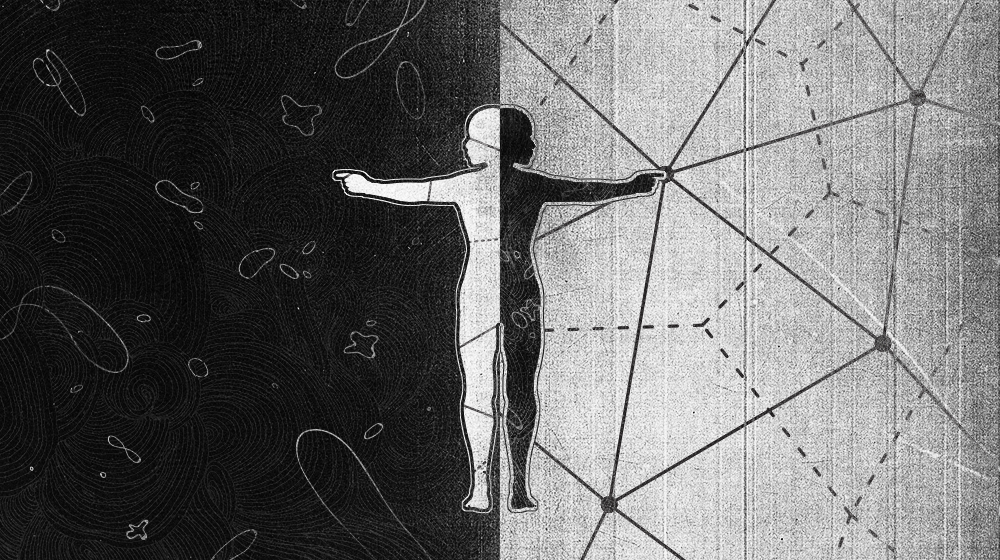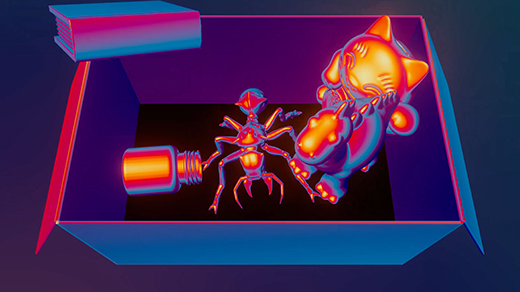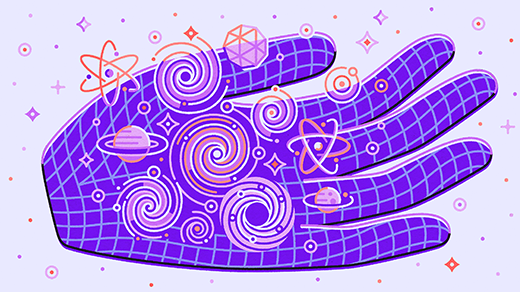String Theory Meets Loop Quantum Gravity

Eight decades have passed since physicists realized that the theories of quantum mechanics and gravity don’t fit together, and the puzzle of how to combine the two remains unsolved. In the last few decades, researchers have pursued the problem in two separate programs — string theory and loop quantum gravity — that are widely considered incompatible by their practitioners. But now some scientists argue that joining forces is the way forward.
Among the attempts to unify quantum theory and gravity, string theory has attracted the most attention. Its premise is simple: Everything is made of tiny strings. The strings may be closed unto themselves or have loose ends; they can vibrate, stretch, join or split. And in these manifold appearances lie the explanations for all phenomena we observe, both matter and space-time included.
Loop quantum gravity, by contrast, is concerned less with the matter that inhabits space-time than with the quantum properties of space-time itself. In loop quantum gravity, or LQG, space-time is a network. The smooth background of Einstein’s theory of gravity is replaced by nodes and links to which quantum properties are assigned. In this way, space is built up of discrete chunks. LQG is in large part a study of these chunks.
This approach has long been thought incompatible with string theory. Indeed, the conceptual differences are obvious and profound. For starters, LQG studies bits of space-time, whereas string theory investigates the behavior of objects within space-time. Specific technical problems separate the fields. String theory requires that space-time have 10 dimensions; LQG doesn’t work in higher dimensions. String theory also implies the existence of supersymmetry, in which all known particles have yet-undiscovered partners. Supersymmetry isn’t a feature of LQG.
These and other differences have split the theoretical physics community into deeply divergent camps. “Conferences have segregated,” said Jorge Pullin, a physicist at Louisiana State University and co-author of an LQG textbook. “Loopy people go to loopy conferences. Stringy people go to stringy conferences. They don’t even go to ‘physics’ conferences anymore. I think it’s unfortunate that it developed this way.”
Emily Fuhrman for Quanta Magazine, with text by Natalie Wolchover and art direction by Olena Shmahalo.
But a number of factors may be pushing the camps closer together. New theoretical findings have revealed potential similarities between LQG and string theory. A young generation of string theorists has begun to look outside string theory for methods and tools that might be useful in the quest to understand how to create a “theory of everything.” And a still-raw paradox involving black holes and information loss has given everyone a fresh dose of humility.
Moreover, in the absence of experimental evidence for either string theory or LQG, mathematical proof that the two are in fact opposite sides of the same coin would bolster the argument that physicists are progressing toward the correct theory of everything. Combining LQG and string theory would truly make it the only game in town.
An Unexpected Link
An effort to solve some of LQG’s own internal problems has led to the first surprising link with string theory. Physicists who study LQG lack a clear understanding of how to zoom out from their network of space-time chunks and arrive at a large-scale description of space-time that dovetails with Einstein’s general theory of relativity — our best theory of gravity. More worrying still, their theory can’t reconcile the special case in which gravity can be neglected. It’s a malaise that befalls any approach reliant on chunking-up space-time: In Einstein’s theory of special relativity, an object will appear to contract depending on how fast an observer is moving relative to it. This contraction also affects the size of space-time chunks, which are then perceived differently by observers with different velocities. The discrepancy leads to problems with the central tenet of Einstein’s theory — that the laws of physics should be the same no matter what the observer’s velocity.
“It’s difficult to introduce discrete structures without running into difficulties with special relativity,” said Pullin. In a brief paper he wrote in 2014 with frequent collaborator Rodolfo Gambini, a physicist at the University of the Republic in Montevideo, Uruguay, Pullin argued that making LQG compatible with special relativity necessitates interactions that are similar to those found in string theory.
That the two approaches have something in common seemed likely to Pullin since a seminal discovery in the late 1990s by Juan Maldacena, a physicist at the Institute for Advanced Study in Princeton, N.J. Maldacena matched up a gravitational theory in a so-called anti-de Sitter (AdS) space-time with a field theory (CFT — the “C” is for “conformal”) on the boundary of the space-time. By using this AdS/CFT identification, the gravitational theory can be described by the better-understood field theory.
The full version of the duality is a conjecture, but it has a well-understood limiting case that string theory plays no role in. Because strings don’t matter in this limiting case, it should be shared by any theory of quantum gravity. Pullin sees this as a contact point.
Video: In this artist’s conception, the network underlying space-time in loop quantum gravity is shown as a series of colored faces. The video shows the behavior of space-time at the Planck scale, the smallest possible area. If we were to zoom out, quantum details would disappear, and space-time would begin to resemble the smooth, continuous geometry of classical physics.
T. Thiemann/Albert Einstein Institute/Milde Marketing/Exozet
Herman Verlinde, a theoretical physicist at Princeton University who frequently works on string theory, finds it plausible that methods from LQG can help illuminate the gravity side of the duality. In a recent paper, Verlinde looked at AdS/CFT in a simplified model with only two dimensions of space and one of time, or “2+1” as physicists say. He found that the AdS space can be described by a network like those used in LQG. Even though the construction presently only works in 2+1, it offers a new way to think about gravity. Verlinde hopes to generalize the model to higher dimensions. “Loop quantum gravity has been seen too narrowly. My approach is to be inclusive. It’s much more intellectually forward-looking,” he said.
But even having successfully combined LQG methods with string theory to make headway in anti-de Sitter space, the question remains: How useful is that combination? Anti-de Sitter space-times have a negative cosmological constant (a number that describes the large-scale geometry of the universe); our universe has a positive one. We just don’t inhabit the mathematical construct that is AdS space.
Verlinde is pragmatic. “One idea is that [for a positive cosmological constant] one needs a totally new theory,” he said. “Then the question is how different that theory is going to look. AdS is at the moment the best hint for the structure we are looking for, and then we have to find the twist to get a positive cosmological constant.” He thinks it’s time well spent: “Though [AdS] doesn’t describe our world, it will teach us some lessons that will guide us where to go.”
Coming Together in a Black Hole
Verlinde and Pullin both point to another chance for the string theory and loop quantum gravity communities to come together: the mysterious fate of information that falls into a black hole. In 2012, four researchers based at the University of California, Santa Barbara, highlighted an internal contradiction in the prevailing theory. They argued that requiring a black hole to let information escape would destroy the delicate structure of empty space around the black hole’s horizon, thereby creating a highly energetic barrier — a black hole “firewall.” This firewall, however, is incompatible with the equivalence principle that underlies general relativity, which holds that observers can’t tell whether they’ve crossed the horizon. The incompatibility roiled string theorists, who thought they understood black hole information and now must revisit their notebooks.
But this isn’t a conundrum only for string theorists. “This whole discussion about the black hole firewalls took place mostly within the string theory community, which I don’t understand,” Verlinde said. “These questions about quantum information, and entanglement, and how to construct a [mathematical] Hilbert space – that’s exactly what people in loop quantum gravity have been working on for a long time.”
Meanwhile, in a development that went unnoted by much of the string community, the barrier once posed by supersymmetry and extra dimensions has fallen as well. A group around Thomas Thiemann at Friedrich-Alexander University in Erlangen, Germany, has extended LQG to higher dimensions and included supersymmetry, both of which were formerly the territory of string theory.
More recently, Norbert Bodendorfer, a former student of Thiemann’s who is now at the University of Warsaw, has applied methods of LQG’s loop quantization to anti-de Sitter space. He argues that LQG can be useful for the AdS/CFT duality in situations where string theorists don’t know how to perform gravitational computations. Bodendorfer feels that the former chasm between string theory and LQG is fading away. “On some occasions I’ve had the impression that string theorists knew very little about LQG and didn’t want to talk about it,” he said. “But [the] younger people in string theory, they are very open-minded. They are very interested what is going on at the interface.”
“The biggest difference is in how we define our questions,” said Verlinde. “It’s more sociological than scientific, unfortunately.” He doesn’t think the two approaches are in conflict: “I’ve always viewed [string theory and loop quantum gravity] as parts of the same description. LQG is a method, it’s not a theory. It’s a method to think of quantum mechanics and geometry. It’s a method that string theorists can use and are actually using. These things are not incompatible.”
Not everyone is so convinced. Moshe Rozali, a string theorist at the University of British Columbia, remains skeptical of LQG: “The reason why I personally don’t work on LQG is the issue with special relativity,” he said. “If your approach does not respect the symmetries of special relativity from the outset, then you basically need a miracle to happen at one of your intermediate steps.” Still, Rozali said, some of the mathematical tools developed in LQG might come in handy. “I don’t think that there is any likelihood that string theory and LQG are going to converge to some middle ground,” he said. “But the methods are what people normally care about, and these are similar enough; the mathematical methods could have some overlap.”
Not everyone on the LQG side expects the two will merge either. Carlo Rovelli, a physicist at the University of Marseille and a founding father of LQG, believes his field ascendant. “The string planet is infinitely less arrogant than ten years ago, especially after the bitter disappointment of the non-appearance of supersymmetric particles,” he said. “It is possible that the two theories could be parts of a common solution … but I myself think it is unlikely. String theory seems to me to have failed to deliver what it had promised in the ’80s, and is one of the many ‘nice-idea-but-nature-is-not-like-that’ that dot the history of science. I do not really understand how can people still have hope in it.”
For Pullin, declaring victory seems premature: “There are LQG people now saying, ‘We are the only game in town.’ I don’t subscribe to this way of arguing. I think both theories are vastly incomplete.”
This article was reprinted on Wired.com and BusinessInsider.com.



